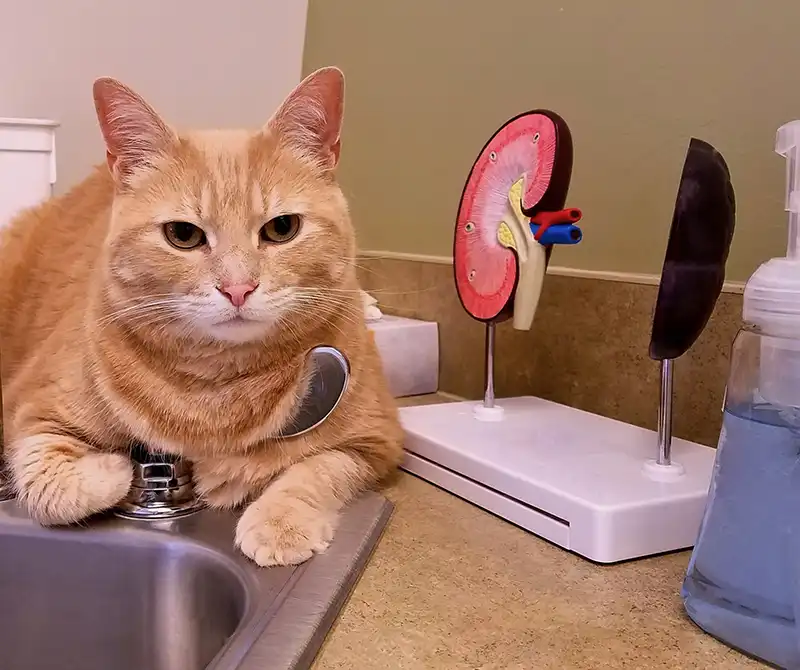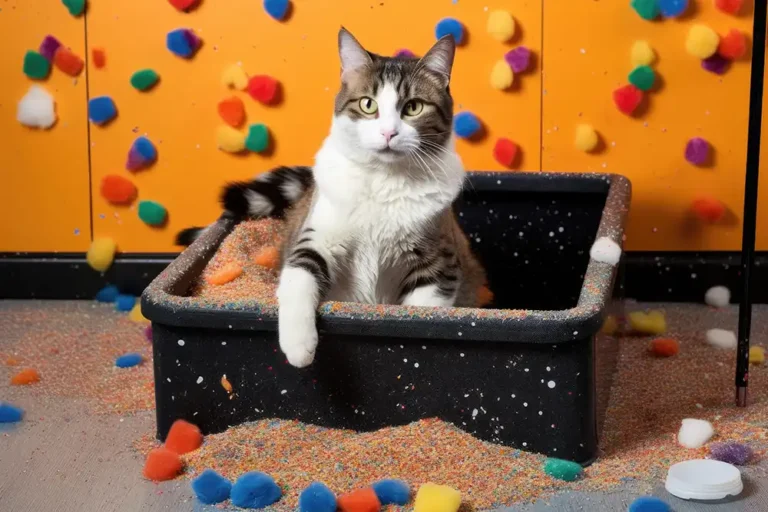Understanding Cat Kidney Issues: Symptoms, Treatment, and Management
Learning your cat may have cat kidney issues can be concerning, even though they are quite common. However, you can navigate treatment paths and management practices with the proper knowledge. This article directly addresses the essentials, from spotting symptoms to providing ongoing care for cats with cat kidney issues.
Key Takeaways
- Early detection and proper management of your cat’s kidneys and chronic kidney disease is important to having your cat’s life be as long as possible, as kidneys perform critical functions like regulating electrolyte concentration, filtering blood, and preventing toxin accumulation.
- Early disease symptoms in your cat’s kidneys may include increased thirst and urination frequency. Advanced symptoms include like weight loss and vomiting and may signal progression to potential chronic kidney failure, kidney failure, or indicate polycystic kidney disease.
- Combing dietary modifications, proper hydration, medications, and nutritional supplements, along with long-term management may slow the disease progression and lead to a long, enjoyable life with your furry loved one.
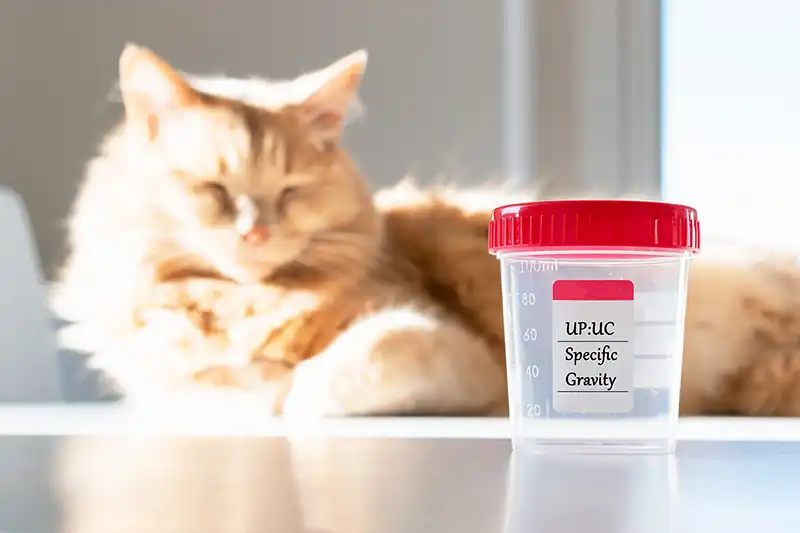
Understanding Feline Kidney Function
Cat’s kidneys serve as the body’s natural filtration system, which remove waste products from the bloodstream. By regulating blood pressure and producing hormones that aid in producing healthy red blood cells, your cat’s kidneys also play a crucial role in maintaining balanced levels of essential minerals such as potassium and sodium. Acting as guardians for your cat’s well-being, their kidneys filter out impurities from their blood and prevent toxic buildup within their body.
If these vital capabilities become compromised due to failing kidneys or acute kidney failure, it highlights the importance early diagnosis and trying to maintain as much kidney function as possible.
The Importance of Healthy Kidneys & Chronic Kidney Failure
The kidneys are vital organs in a cat’s body, and can be overlooked at times due to masking symptoms. Their kidneys perform important functions such as maintaining electrolyte concentration and balance, regulating fluid levels, filtering waste products, and retaining essential nutrients. They play a significant role in protein metabolism too while preventing appetite loss by concentrating urine.
Overall, the health and vitality of cats heavily depend on healthy kidney function. As the central hub for essential bodily processes like hydration and nutrient retention, any issues with these organs can significantly impact a feline’s overall well-being.
In particular, the proper functioning of kidneys is necessary for keeping fluids balanced within the body and effectively removing toxins from the blood. Additionally, it supports normal metabolic activities, directly influencing factors such as appetite. Awareness of your cat’s renal health is important since it directly correlates to its quality of life.
By prioritizing good kidney care, you ensure your pet maintains optimal internal equilibrium, leading to improved energy, vitality, and longevity.
Without a doubt, your cat’s kidneys bear immense importance when caring for your fuzzy companion.
How Kidneys Influence a Cat’s Overall Health
Your cat’s kidneys have a direct impact on its overall well-being. Symptoms such as weakness, lack of interest in activities, loss of appetite, increased thirst, and urination can be indicative of mild to moderate chronic kidney disease and should be investigated quickly.
Early diagnosis can lead to maintaining healthy red blood cells to ensure a high quality of life for your feline. With early diagnosis, appropriate veterinary medicine, and blood pressure checks, your cats’ kidney disease problems can be managed and lead to an extended lifespan.
Cats’ kidney disease may manifest through various signs like poor hair texture or weak muscles due to low levels of potassium seen in feline patients. While chronic kidney disease in cats often does not cause physical discomfort, it can lead to systemic effects that affect long-term well-being and comfort.
Feline Infectious Peritonitis
Sometimes, feline infectious peritonitis, a form of coronavirus in cats, might look like a problem with your cat’s kidneys. Feline coronavirus is often benign, and while it may cause mild diarrhea, it can generally pass through.
Clinical signs can vary, but with blood tests, you can determine if the issue is with the red blood cells or red blood cell count, white blood cell count, renal insufficiency, or just feline infectious peritonitis.
Determining If It’s Kidney Damage or Something Else
Recognizing potential kidney disease in cats is essential, given their crucial role in keeping your loved one healthy. Awareness about these issues helps identify them quickly, so effective measures can be taken, like introducing a kidney diet or performing a kidney biopsy if complications with your cat’s kidneys are suspected.
Sometimes, your cat’s kidneys may be ok but have minor kidney infections or kidney stones, which are treatable with medication, a kidney diet, surgery, or lithotripsy (a sound wave procedure that breaks apart kidney stones). A urine culture can help determine if kidney infections are present.
A veterinarian can perform a kidney biopsy if lesions or cancer are suspected. To properly assess kidney damage or other illnesses, consulting with a veterinary medicine practitioner should remain high on your list to help your kitty maintain optimum kidney function.
Identifying Symptoms of Kidney Damage in Cats
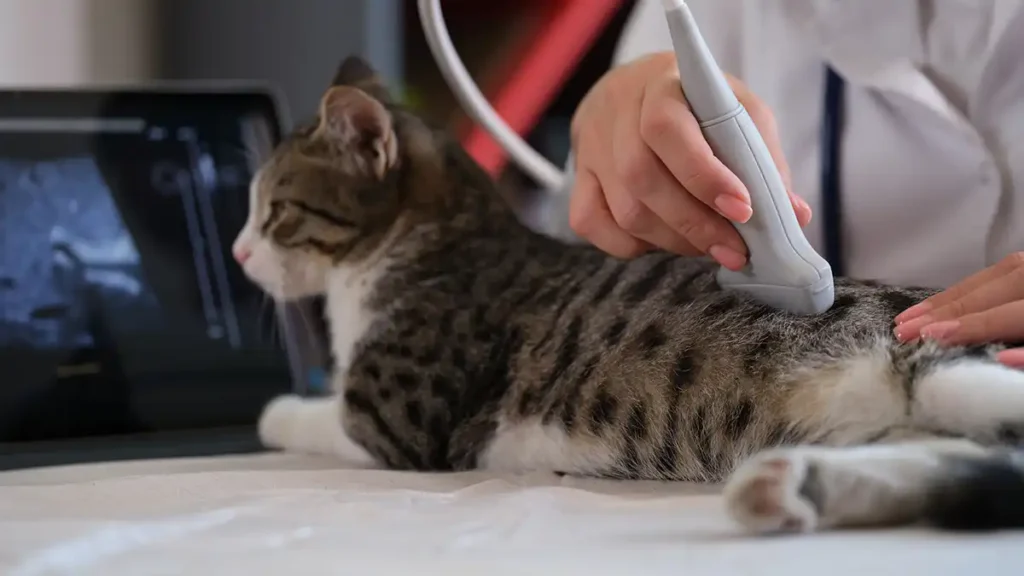
Detecting kidney problems in cats at an early stage can significantly impact their management and treatment. Some signs may be subtle, while others are more obvious. For example, increased thirst and changes in dilute urine concentration are typical early indicators of kidney issues. As the kidneys work to eliminate waste by producing more dilute urine, your cat may drink more water than usual. These alterations in urinary habits could indicate kidney damage.
So, how do we distinguish between initial warning signals and advanced symptoms of failing kidneys for prompt diagnosis?
Here are some red flags to watch out for that can help identify potential issues before acute renal failure causes problems:
- Excessive intake of fluids due to inefficient functioning of the organs and showing clinical signs of early chronic kidney failure
- Variations in bathroom frequency as excess fluid is getting eliminated through dilute urine production
- Presence of urine protein after the vet takes a urine culture
It is essential to note if these physical cues persist or worsen over time, so proper steps towards managing these health concerns through blood tests and if you manage blood pressure well. High blood pressure can help early diagnosis of symptoms.
Recognizing Early Signs of Trouble
Recognizing the signs of kidney disease in cats can be tricky, as they may initially appear minor or easily missed. For most cats, these early indicators include if they lose weight, have increased urination frequency and water intake, poor coat condition, changes in appetite or bad breath.
While these symptoms may seem insignificant at first glance, they serve as warning signals for potential kidney issues or early stages of acute renal failure or chronic kidney failure.
If you notice any of these clinical signs, it is important to monitor your cat’s condition and consult with a veterinarian. Monitoring your cat’s blood pressure can be your best friend during these times. One study found that roughly 60% of cats with old-age kidney failure have hypertension. Elderly cats in the early stages of kidney disease may also have high blood pressure, which can contribute to end-stage kidney failure.
Aside from the aforementioned subtle indications, more severe symptoms may manifest later, including if they lose weight or have a drastic increase in thirst and hunger levels, which could allude to progressing stages of kidney disease developing within your feline companion.
It is vital not to dismiss even seemingly minor clues that might point towards underlying problems related to this condition, so being vigilant about observing any shifts concerning their behavior patterns would ultimately prove beneficial when taking preventative measures while seeking help with veterinarian medicine were deemed necessary regarding proper medical treatment.
Toxic Plants

A common cause of kidney disease in cats can be ingesting cleaning fluids or toxic plants. Toxic plants such as poinsettias, including their pollen, flower, stems, and leaves, are poisonous to cats. While poinsettias are part of the euphorbiaceae family, but plants in the Lilium or Hemerocallis family are also toxic – these include lilies and daylilies. If ingested, these plants can cause kidney failure in cats, with sudden onset of lethargy, decreased appetite, vomiting, or increased or decreased thirst and urination with dehydration. Getting your cat immediate veterinary medicine in cases like these is critical.
When to Be Concerned: Advanced Symptoms & Acute Renal Failure
As acute renal failure progresses, its symptoms become more severe and complex to ignore. These may include weight loss, decreased appetite, vomiting, diarrhea, increased thirst or urination frequency, and the presence of mouth ulcers. Additionally, the physical appearance can change with sunken eyes, an inability to walk, or trouble eliminating waste products.
These signs indicate advanced stages of kidney failure. Kidney failure can also cause anemia and is another concern related to inadequate production of erythropoietin by the kidneys.
In adequate erythropoietin production, red blood cell production in the bone marrow is reduced, affecting their blood count and ability to carry oxygen throughout the body. The hormone, erythropoietin stimulates the bone marrow to produce red blood cells. Per the Cleveland Clinic, the leading kidney center in the country, “Erythropoietin is an important and essential hormone that tells your [cat’s] bone marrow when to make more red blood cells.”
Besides affecting blood flow, kidney diseases can also contribute to typically low numbers of sufficiently functional white blood cells and red blood cells due to an impairment causing their kidneys to be unable to perform optimally.
Hence, understanding different types and levels would help devise efficient treatment methods for improved health outcomes.
The Spectrum of Chronic Kidney Disease in Cats
Kidney disease in cats encompasses a wide range of conditions, from gradual development over time to sudden onset. Among these conditions is chronic kidney disease (CKD). Older cats typically lose some of their kidney function due to old age, as do most animals. One-time events as caused by bacterial infections such as pyelonephritis can also cause significant damage to the kidneys.
Similarly, acute renal failure can involve a sudden loss of kidney function due to toxins, severe infections, or shock. Knowing how acute and chronic renal failures differ is crucial for effectively managing these disorders and can lead to effective treatment once determined.
Acute vs. Chronic Conditions
In cats, the sudden loss of the ability to filter waste from blood is called acute kidney injury, which used to be termed as ‘acute kidney failure’ (often caused by toxins, trauma, blockages, or infections). Chronic kidney disease (CKD), also referred to as chronic kidney failure and failing kidneys, tends to be more gradual due to various factors such as infections, congenital malformations, high blood pressure (hypertension) and other health problems.
It is possible to recover from acute renal failure or injury, however cats with CKD tend to have a life-long, incurable health condition. Acute renal failure can subside if the determining contaminant or blockage gets removed from your cat’s kidneys.
Polycystic kidney disease, resulting in numerous cysts forming on the organs, is one condition that can cause cats to have CKD. Knowing these conditions as a pet owner can give you knowledge to effectively treat your cat’s kidneys with proper care and treatment.
Specific Kidney Ailments
Cats may experience a range of kidney issues, each with its distinct symptoms and difficulties. Some examples include stones in the kidneys or ureters, which can cause blockages leading to cats with chronic kidney disease if not adequately addressed.
Known culprits for cats with CKD, including bacterial infections (pyelonephritis) and viral infections such as Feline Leukemia Virus (FeLV), Feline Immunodeficiency Virus (FIV), and Feline Infectious Peritonitis (FIP), cause both acute and chronic forms of CKD due to direct trauma caused to the kidneys and surrounding organs. The disease process damages the tissue and can cause irreversible damage. As a result your cat’s kidney function may be compromised.
Accurately diagnosing these various conditions in cats with CKD within veterinary medicine practice is crucial. This process requires a thorough veterinarian understanding of how different factors contribute to chronic renal failure. This includes potential underlying causes (like those mentioned above) and proper handling techniques explicitly tailored for cats during their care phase before returning home.
Diagnosing Kidney Problems & Kidney Failure in Cats
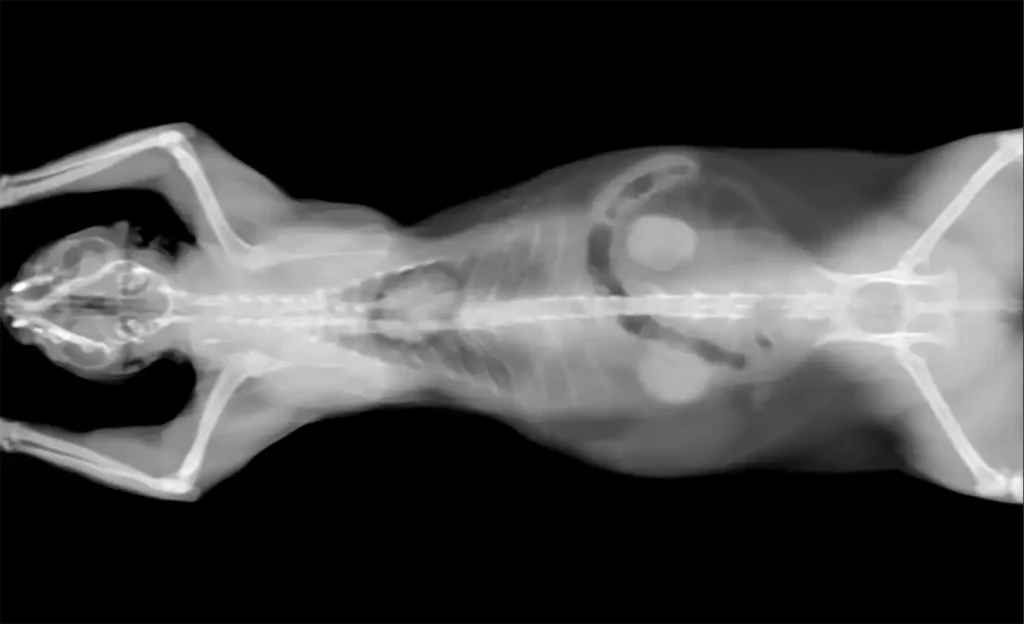
Detecting kidney issues in cats is a thorough process that includes blood tests, urine tests, and abdominal ultrasound imaging to assess the extent of damage.
The primary measures for evaluating kidney function are blood urea nitrogen (BUN) levels and creatinine, which determine how effectively the kidneys are filtering out waste products.
Additional diagnostic methods are used alongside these key indicators, including the abdominal ultrasound, which can show kidney health through images.
Veterinarians may uncover clinical signs in obtaining a comprehensive understanding of feline kidney health through urine samples and ultrasounds to analyze any possible harm done to this organ system. These tests provide valuable information regarding overall functioning and potential abnormalities within cats’ bodies- specifically their kidneys – through analyzing components like BUN levels or creative protein production. Both are significant players in detecting renal failure concerns with pets at hand.
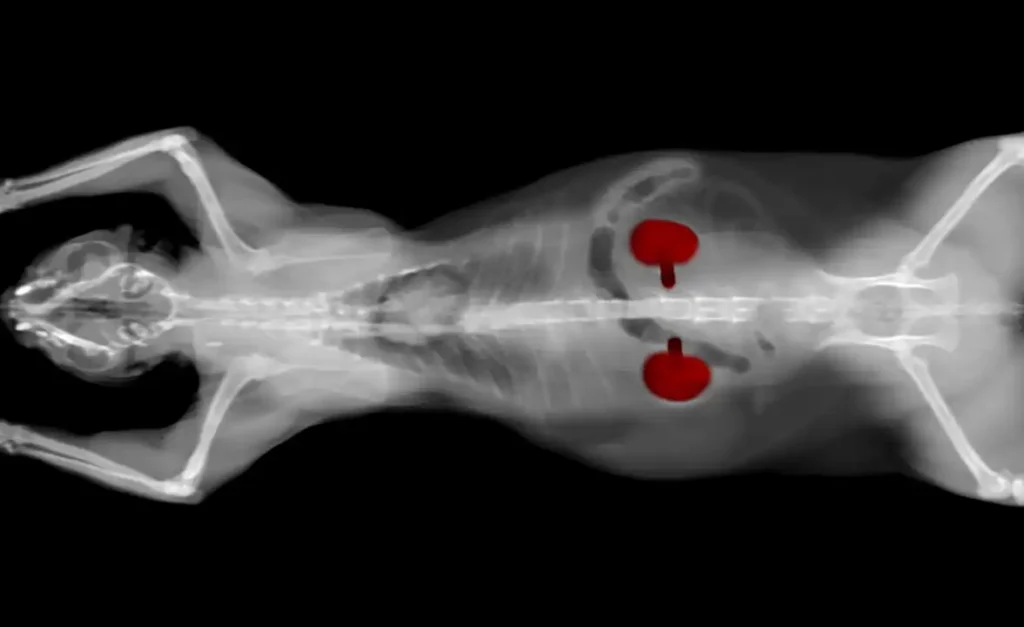
Blood Urea Nitrogen and Serum Creatinine: Key Indicators & Clinical Signs
Veterinarians diagnose chronic kidney disease (CKD) in cats through analyzing waste products. Waste products such as blood urea nitrogen (BUN) and creatinine, are common indicators used to determine kidney function. Another important diagnostic test, SDMA (symmetric dimethylarginine), can detect early signs of renal failure before significant increases in BUN and serum creatinine levels.
Besides these tests, veterinarian medicine may use other tools to identify kidney issues. For example, urine-specific gravity and examining blood samples can provide insights into a cat’s overall renal health status.
Monitoring for changes or abnormalities in these factors is crucial for detecting potential problems at an earlier stage and implementing appropriate treatment measures to manage CKD effectively.
Additional Diagnostic Tools for Kidney Health
Veterinarians use a range diagnostic tools to gain a complete understanding of a cat’s kidney health in addition to blood and urine tests. Some may include:
- Specific gravity (USG) in urine. A lab test that evaluates how well the kidneys can dilute or concentrate fluids and has a certain level associated with it.
- Renal biopsies. Pieces of tissue are extracted from the kidney to provide definitive diagnoses for kidney disease or cancer.
- Urine cultures are often recommended for cats with chronic kidney disease (CKD) to help prevent infections in both their bladder and kidneys. Veterinarians often recommend regular follow ups.
All of these tests allow vets to treat your feline kidney function and diagnose potential issues with greater accuracy and better outcomes as a result.
Having explored the diagnosis process, let’s look at how the treatment options for cats with renal diseases.
Treatment Options for Cats with Kidney Disease

Kidney disease management in cats involves a comprehensive approach encompassing multiple strategies. Your vet will likely ask you to implement a carefully managed diet, hydration with fresh water, medication administration, and water-soluble vitamins. IV fluids and subcutaneous fluid therapy are also standard methods to hydrate feline patients.
A specific dietary plan is essential for cats with this condition. It typically includes reduced protein and phosphorus levels tailored to their individual needs. Managing complications related to kidney disease may involve using phosphate binders, potassium supplementation, B vitamin intake promotion, or anti-emetics.
Cats with CKD can manage and monitor their symptoms, and a prescription diet change, carefully managed diet, and even some human medications for treating high blood pressure can help. A calcium channel blocker called Amlodipine is one of the human medications that can help manage blood pressure. Alternatively, angiotensin-converting enzyme inhibitors (ACE inhibitors) may be prescribed. It is important to monitor as you do not want have low blood pressure or too high blood pressure. Low blood pressure may be a sign of over medication.
A vet may also prescribe a vitamin D supplement for cats with CKD, called Calcitriol, an active form of vitamin D. Water soluble vitamins and a particular diet may be prescribed along with a prescription diet change.
Crucial treatment measures are also beneficial when paying attention to other aspects becomes part-and-parcel for these pets battling this illness daily; specifically, addressing proper nutrition requirements alongside sufficient hydration maintenance holds vital importance.
Managing Diet and Hydration
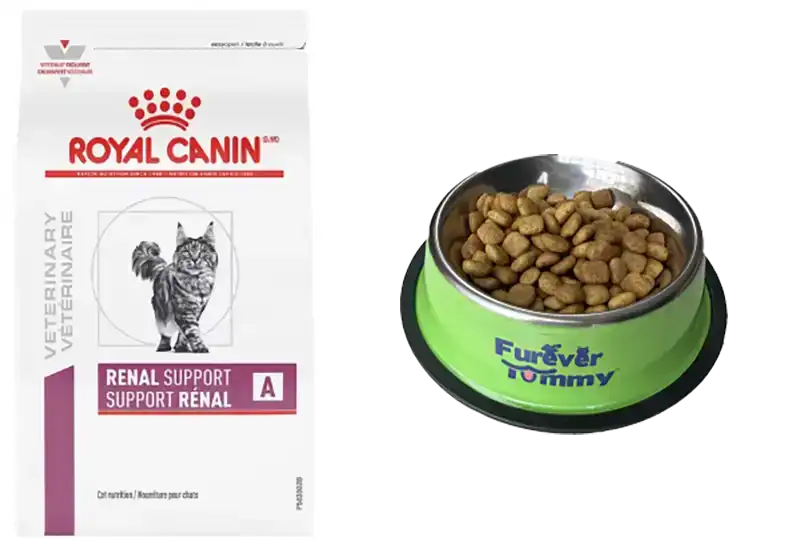
Proper management of diet and hydration is crucial for effectively treating feline kidney disease. A specialized diet for cats with this condition typically involves reducing both phosphorus and protein in addition to sodium levels while including omega-3 fatty acids to combat inflammation and oxidative stress. Both phosphorus and too much sodium can be hard on cats with CKD. A special diet may be needed.
It is also essential to ensure that affected cats have unlimited access to fresh water and potentially added water-soluble vitamins to help them regulate phosphorus and sodium levels, as their impaired urine concentration leads to increased thirst.
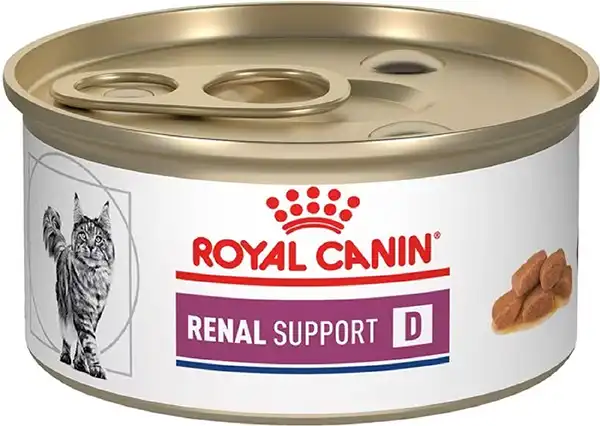
Regular monitoring of weight and precise portioning of food is necessary for maintaining an adequate calorie density and good body condition in CKD-affected cats. Dietary measures, medications, and supplements are critical in managing kidney disease.
Medications and Supplements
To diet and stay hydrated, cats with kidney disease require medication and water-soluble vitamins for proper management. To address hypertension, Amlodipine is commonly prescribed as the first line of treatment. At the same time, benazepril (angiotensin-converting enzyme inhibitors, an ACE inhibitor) or telmisartan (an ARB) can help control proteinuria levels. Various supplements such as Azodyl are known to reduce blood urea nitrogen levels, Epakitin aids in lowering phosphorus levels, and omega-3 fatty acids are recommended to decrease inflammation.
These can improve your cat’s quality of life and longevity.
Long-Term Management of Cat Kidney Disease
Long-term management techniques are needed to treat cats with kidney disease. These involve keeping track of blood pressure levels, managing the effects of anemia, and offering supportive care for impacted cats.
To reduce the advancement of kidney disease and provide the necessary support to affected cats, let’s delve into methods for slowing down its progression and understand what types of supportive measures should be taken.
Slowing the Progression of Kidney Disease
It is important to address hypertension and proteinuria in your cat when evaluating it for kidney disease. This may include making adjustments to their diet. Hypertension affects approximately 20-65% of cats with CKD and can significantly impact their overall lifespan.
To manage your cat’s blood pressure and prevent further kidney damage, your veterinarian may prescribe medications like propranolol, atenolol, or enalapril.
Dietary modifications play a crucial role in supporting cats with kidney disease. By limiting protein intake within a recommended range of 28-35%, calculated on a dry matter basis, we can reduce strain on the kidneys and help preserve their function.
Cat owners must provide this supportive care for felines affected by kidney disease as it is integral to managing high blood pressure levels and maintaining healthy kidneys.
Supportive Care for Affected Cats
When you love your cat, it goes without saying you will do everything you can to care for it. Chronic kidney disease in cats, if left untreated, can lead to anemia due to a decrease in erythropoietin production. This tends to cause symptoms such as fatigue and loss of pink in the gums.
Erythropoietin replacement therapy has the ability to correct anemia and improve your cat’s appetite and activity level while also potentially slowing down the progression of kidney disease.
In cases where end-stage kidney failure occurs, you can provide supportive measures for comfort purposes. These include ensuring your cat stays warm and providing easy access to food, fresh water, a clean litter box, and human companionship.
With diligent management and care practices in place from early on, we can effectively prevent various kidney-related issues in our beloved feline friends.
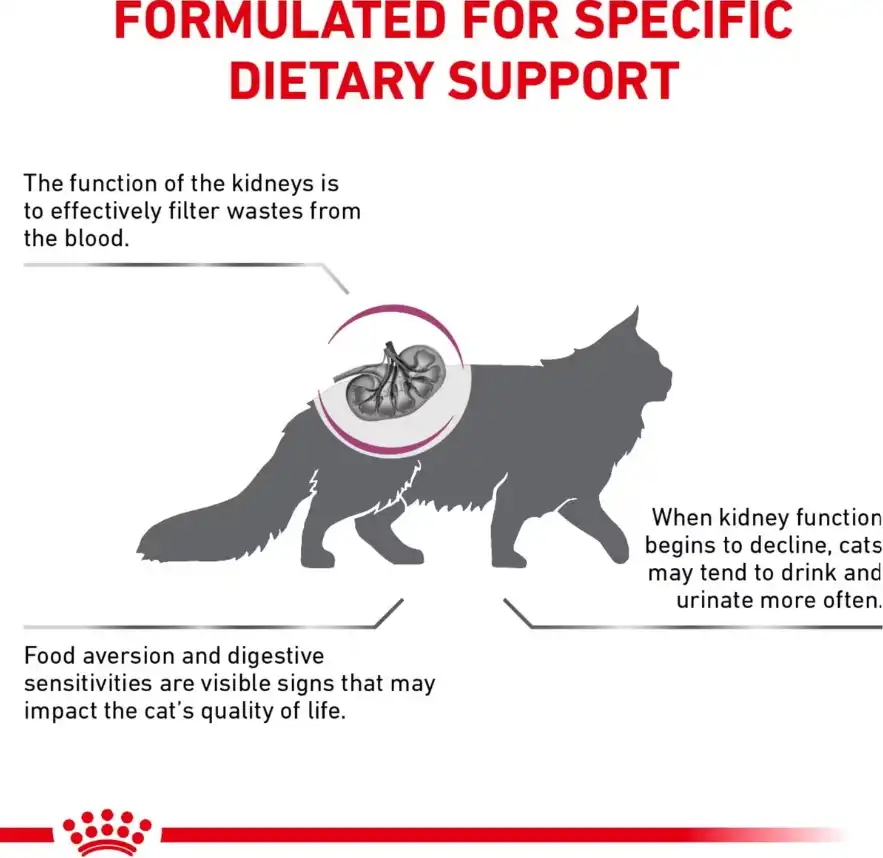
Preventing Cat Kidney Issues
Ensuring the well-being of your feline friend and preventing any kidney problems involves following specific measures. These include steering clear of potential toxins such as cleaning fluids and human medications, providing an unending supply of fresh water, and promoting a nutritious diet and good elimination of waste products.
Safeguarding against these issues also entails regular veterinarian check-ups to catch any early warning signs.
Lifestyle Adjustments for Your Feline’s Kidney Health
Small changes to your cat’s lifestyle can greatly improve its kidney health and happiness. Switching your cat’s diet to moist, canned food is one way of supporting healthy kidneys. The added moisture makes it less strenuous on its kidneys due to increased water intake. In critical situations, you can implement IV fluids for corrective care.
Keeping your cat’s litter box clean and free of cleaning fluids and other chemicals is also helpful.
Regular check-ups at the veterinarian may also be needed to address ongoing health concerns and to keep an eye on your feline’s condition. These visits allow for routine detection and treatment of any potential issues with your cat’s kidney disease.
Regular Veterinary Screenings
Regular veterinary check-ups give you a leg up on detecting and diagnosing chronic kidney disease in cats in early stages. Start annual screenings for this condition when your cat reaches 5-6 years of age, as it will provide you and your veterinarian a baseline to compare its health as it ages.
Prognosis and Life Expectancy for Cats with Kidney Disease
The outlook and expected lifespan of your cat diagnosed with kidney disease can vary greatly depending on what stage it is caught and what type of treatment is implemented.
If caught early, many cats can lead a long-life span if they receive adequate treatment for hypertension or your cat’s CKD root cause. According to the Journal of Veterinary Medicine, the average lifespan of a cat diagnosed with CKD tends to be 1.5-5+ years.
It may be worrisome, but it’s important to remember that every cat is different and has unique circumstances. Proper management and care can significantly improve the quality of your cat’s life and lifespan despite having CKD. Many cats with CKD enjoy a fulfilling existence through appropriate care, fresh water, and a carefully managed diet.
Summary
Kidney health is one factor in your cat’s overall well-being. Knowing about its kidneys and their function, identifying symptoms of kidney disease, and understanding available treatments is important so you can make informed decisions as a pet parent. Although receiving a diagnosis of kidney disease may seem challenging and overwhelming at first, with early detection, proper management, medication, and preventative care, many cats can live happy and healthy lives despite having this condition.
Frequently Asked Questions
Sources
IRIS – International Renal Interest Society (Pet focused)

